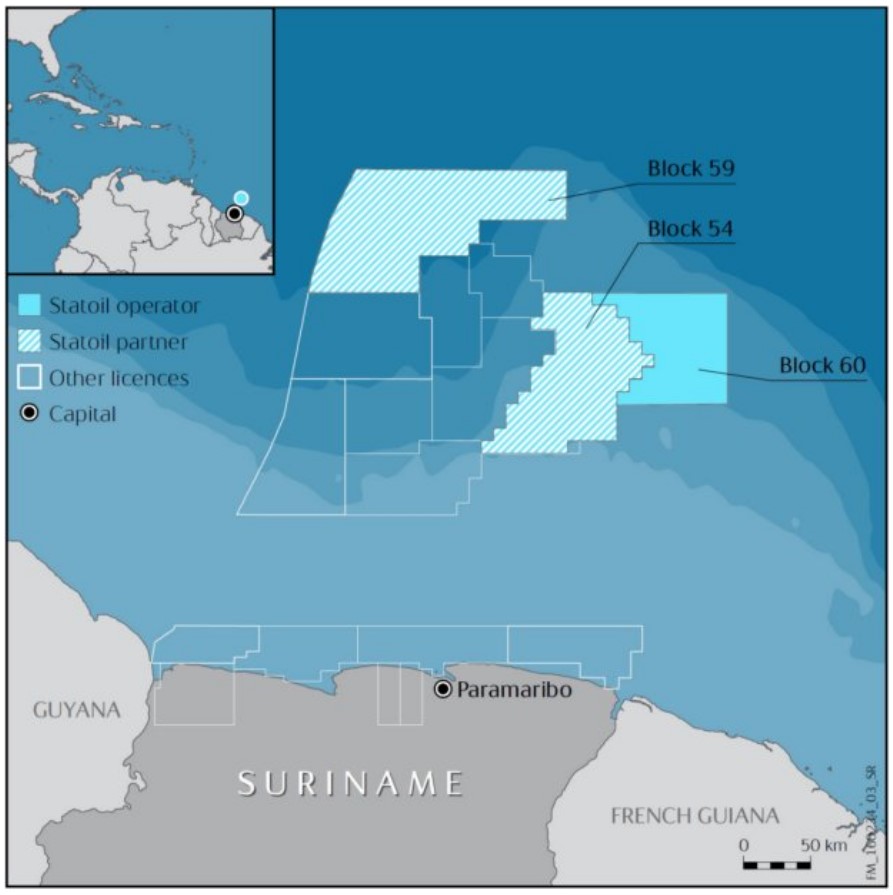Suriname in South America

The Republic of Suriname has been an independent state since 1975. Ranked as the smallest independent country in South America, it lies between Guyana in the west, French Guiana to the east and Brazil to the south. Its economy is dominated by mining, with bauxite as the most important ore. Gold, iron, manganese and copper are also produced, along with oil.
Off the coast, the Guyana Basin has attracted substantial interest as a potential source of petroleum. Where the boundaries with neighbours Guyana and French Guiana ran offshore was long a bone of contention, but a final delineation was achieved in 2007 with UN assistance.

Part of Statoil’s exploration strategy
Oil Investing News characterised oil deposits on the Surinamese continental shelf as massive in 2011.[REMOVE]Fotnote: Attention On Guyana and Suriname Following Tullow Oil Find in French Guiana | INN (investingnews.com). Statoil expressed its interest and acquired in 2013 a 50 per cent interest in the first licence in the area, covering block 54. Tullow, originally an Irish oil company, had the other 50 per cent and was operator. In 2015, Tullow farmed out 20 per cent in the block to US oil company Noble.[REMOVE]Fotnote: Suriname | Tullow Oil plc (LSE: TLW). The water depth on the block ranges from 200 to 1 300 metres.
Suriname opened up in 2016 for more foreign companies to invest in the oil sector and the country in general. Statoil again entered the fray, and signed agreements in 2017 to participate in two further licences in the Guyana Basin. The first exploration phase for both these involved a commitment to acquire seismic data and conduct technical studies. Contracts on production sharing from a possible discovery were negotiated with national oil company Staatsolie Maatschappij Suriname NV.
Block 59 possibly contained an extension of or similar formations to the Liza discovery made in neighbouring Guyana, and Statoil acquired a 33.33 per cent interest. ExxonMobil was the operator and Hess the third partner, each with a one-third holding. A water depth between 2 900-3 500 metres was demanding.
In block 60, adjacent to the Tullow-operated block 54, Statoil became the sole licensee and operator. The water depth was 700-3 000 metres. Nick Maden, senior vice president for exploration in the southern hemisphere, expressed satisfaction that these new blocks strengthened Statoil’s exploration activity in a frontier area with a high potential. “This is in line with our global exploration strategy of accessing early in basins with high exploration potential,” he commented in July 2017.[REMOVE]Fotnote: Stavanger Aftenblad, 14 July 2017, “Statoil fortsetter å lete i Surinam”.
Dashed hopes
The hopes for the first field were nevertheless dashed. Drilling the first exploration well in block 54 encountered nothing, and it was plugged and abandoned in 2017.[REMOVE]Fotnote: Araku-1 Well update | Tullow Oil plc (LSE: TLW).
Blocks 54 and 60 now appear to be out of the picture. In 2021, Equinor said only that the company had interests in block 59, where ExxonMobil was still the operator.[REMOVE]Fotnote: Equinor website.
arrow_backExploration in New ZealandGas from high-risk Algeriaarrow_forward